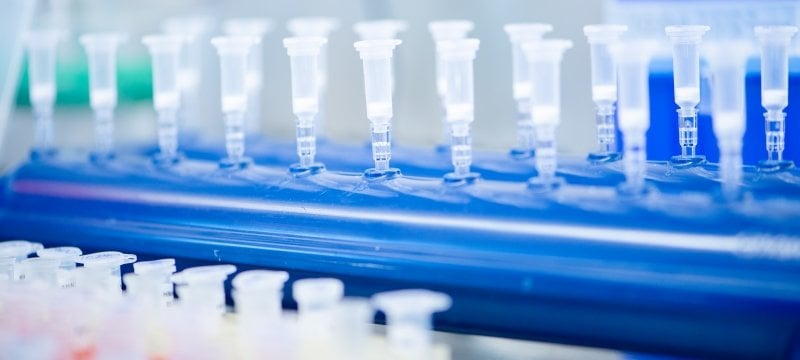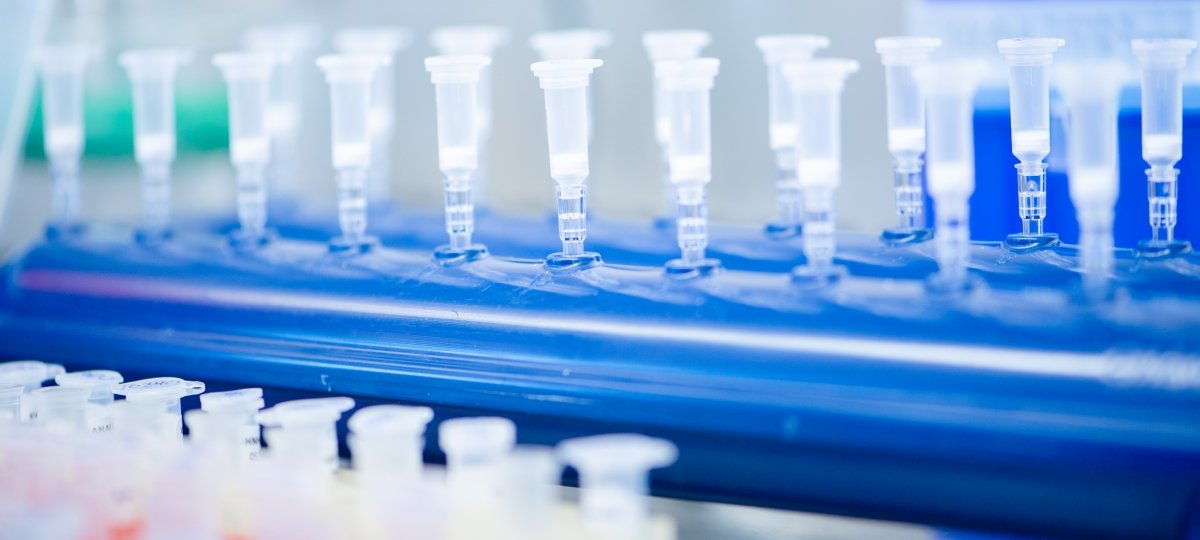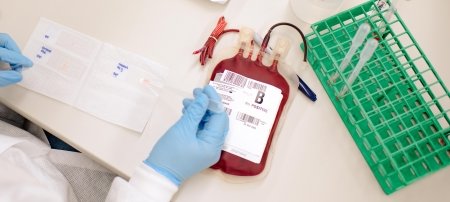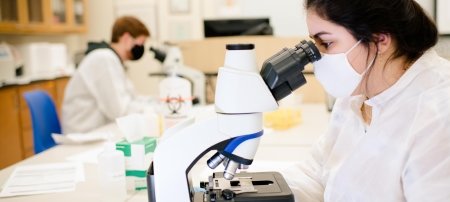At nearly 35,000 samples processed and counting, Michigan Tech’s COVID-19 Testing Laboratory is a lean needle-in-a-haystack hunting operation.
In just three weeks, Michigan Tech was able to open its COVID-19 Testing Laboratory, largely because of faculty and staff — from forestry, biomedical engineering, biology and chemical engineering — and availability of equipment that hunts viruses. It’s called reverse transcription polymerase chain reaction (RT-PCR) testing.
Testing on Demand
Michigan Tech will provide on-demand testing for the University community during the fall 2021 semester. Michigan Tech strongly encourages vaccination against the SARS-CoV-2 virus, which causes COVID-19.
“Because there is so much other genetic information in someone’s nose or throat, finding SARS-CoV-2’s genetic signature in a sample can be like finding a needle in a haystack,” said Karl Meingast, COVID-19 lab manager. “RT-PCR lets us turn that single needle into a million glow-in-the-dark needles. Just come back at night and see if your haystack glows.”
With nearly 35,000 tests processed and counting, Michigan Tech’s COVID-19 diagnostic testing laboratory is an efficient needle-in-a-haystack hunting party.
Glowing Haystacks of Viral Genetics
The Real-Time RT-PCR Diagnostic Panel caught side-eye this summer when the Centers for Disease Control and Prevention (CDC) announced it was retiring the U.S. Food and Drug Administration’s emergency-use authorization for the testing method at the end of 2021. Critics misunderstood — the panel is being retired not because the method isn’t scientifically valid, but because there are more efficient ways to run samples. And with the delta variant causing surges in positive COVID-19 cases around the country, testing efficiency is paramount.
SARS-CoV-2, the virus that causes COVID-19, is a single-stranded ribonucleic acid (RNA) virus. RNA codes for proteins that are capable of carrying out specific cellular functions and SARS-CoV-2 RNA creates a blueprint for proteins to create more virus. RT-PCR allows laboratory staff to replicate and amplify SARS-CoV-2 RNA from a patient’s nose or throat into a large enough amount to detect. That’s what creates the glowing haystack.
How Do Viral Variants Occur?
A virus breaks into your cells’ machinery and uses genetic hacking codes to replicate itself. Often, because viruses replicate with such haste once in a cell, they mess up their own genetic sequence — this is how variants are produced. The more times a virus replicates itself, the higher the probability of mistakes occurring in the replicated genetic sequence. Sometimes those mistakes make a virus more contagious — like the delta variant of COVID-19.
“If there’s nothing there, you can amplify all day and there still won’t be anything there,” said Karyn Fay, recently retired director of the medical laboratory science program and a key member of the COVID-19 testing lab’s founding team, adding that RT-PCR is the gold standard for detecting SARS-CoV-2 in a sample.
“You are measuring SARS-CoV-2 directly and in a way that you can increase the sensitivity of the test through replication. That is why you hear of critical testing applications relying on RT-PCR tests,” said Meingast.
The KingFisher Goes Hunting
Like many labs around the country, in April 2020 the MTU lab relied on the real-time panel and used a QIAGEN purification system for a simple reason: It was available. In December 2020, with support from the Portage Health Foundation, the team made the switch to the KingFisher for RNA extraction.
“When we were determining whether we could create the lab, the QIAGEN test was the only one available,” said Dave Reed, vice president for research at Michigan Tech. “We had the equipment and the expertise. It’s a reliable test and accurate, and we’ve validated it against other labs and tests. But the KingFisher is more efficient and faster.”
Prior to using the KingFisher, lab staff had to manually pipette samples to extract RNA, which requires dexterity, precision, concentration and that most precious of resources: time.
“We’re an assembly line and the KingFisher is like adding a robot to the line,” said Meingast. “The dexterity required for performing RNA extraction is similar to handwriting. Most people have one dominant hand for that — the KingFisher has 96 hands.”
The KingFisher enabled the lab to quadruple the number of tests it could run in a day and back off a grueling six-days-a-week, 12-hours-a-day schedule.
In April 2021, the Michigan Legislature and Gov. Gretchen Whitmer recognized the University for its contributions to community health and safety.
Contract Tracing is Still Key
These test results are so important because they are the data contact tracers use. As Meingast pointed out: “One person’s test result can help inform contact tracers and help limit the spread.”
Testing also helps control outbreaks because those infected individuals are isolated early, limiting contact and spread. Wastewater testing is another means of control, identifying locations where infected individuals might be living.
How Does an mRNA Vaccine Work?
An mRNA vaccine is like boot camp for your immune system — it teaches your body how to make a protein that triggers an immune response. For more information about how mRNA vaccines work, visit the CDC’s Understanding How COVID-19 Vaccines Work website.
“If you have been exposed to someone with COVID-19, you need to remain in quarantine until released by your local health department,” said Kelly Kamm, epidemiologist and assistant professor of kinesiology and integrative physiology. “A negative test does not mean that you are not infected, since it can take up to 14 days after a close contact with an infected person to test positive or show symptoms. Individuals who are fully vaccinated do not need to quarantine unless they develop symptoms.”
Efficient testing methods coupled with mitigation procedures like masking, physical distancing and handwashing are powerful tools to preventing the continued spread of COVID-19.
Michigan Technological University is an R1 public research university founded in 1885 in Houghton, and is home to nearly 7,500 students from more than 60 countries around the world. Consistently ranked among the best universities in the country for return on investment, Michigan's flagship technological university offers more than 185 undergraduate and graduate degree programs in science and technology, engineering, computing, forestry, business, health professions, humanities, mathematics, social sciences, and the arts. The rural campus is situated just miles from Lake Superior in Michigan's Upper Peninsula, offering year-round opportunities for outdoor adventure.






Comments